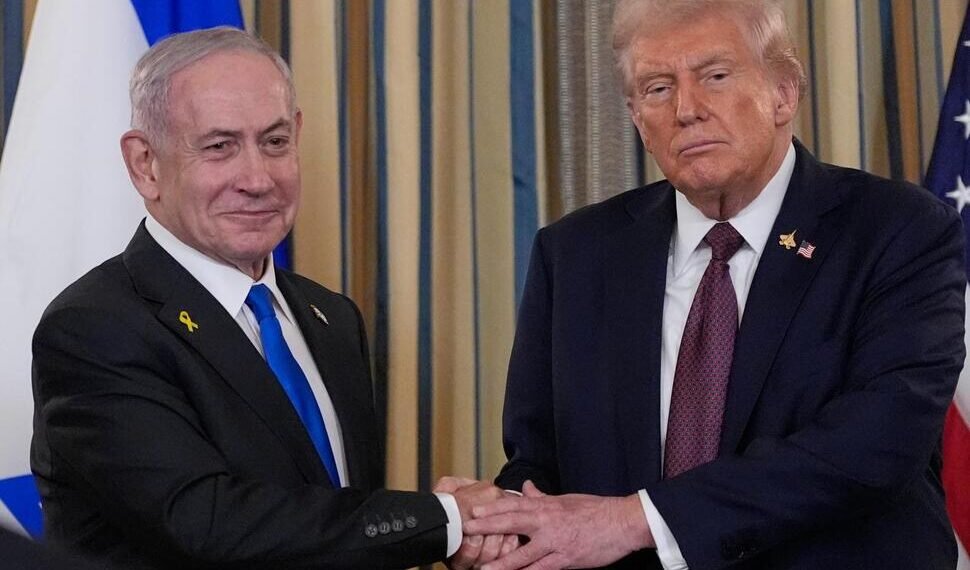Trump’s 20-point Gaza peace proposal includes immediate cease-fire, large-scale prisoner exchanges, and a U.S.-led stabilization force to secure Gaza’s borders.
BY PC Bureau
US President Donald Trump and Israeli Prime Minister Benjamin Netanyahu announced Monday they had agreed on a sweeping new plan to end the war in Gaza. The 2–point proposal, while still uncertain to gain Hamas’s approval, lays out a framework that removes both Israel and Hamas from direct control over the territory’s future — instead placing governance in the hands of a temporary technocratic Palestinian committee overseen by an international body led by Trump himself.
The 20-point plan envisions an immediate cease-fire, large-scale prisoner and hostage exchanges, demilitarization of Gaza, and a flood of humanitarian aid. But its most striking feature is that neither Israel nor Hamas will have any role in administering postwar Gaza. Hamas would be stripped of governance, disarmed, and either reintegrated or allowed safe passage abroad. Israel, for its part, is explicitly barred from annexing or occupying Gaza and is required to withdraw its forces in stages once security conditions are met. In their place, the plan calls for international supervision, a U.S.-led stabilization force to secure borders, and a new “Board of Peace” tasked with managing reconstruction and preparing the ground for eventual Palestinian self-rule.
2/2
Middle East Monitor: The White House releases President Trump’s 20-point peace plan to end Israel’s genocide of Gaza. pic.twitter.com/9tjGCV8h2l— Maha 🇵🇸 (@MahaGazaPal) September 30, 2025
READ: Talks Collapse as Leh Apex Body Protests Wangchuk Arrest, Deaths
By shifting authority away from both warring parties, the plan seeks to break the cycle of conflict that has defined Gaza for decades. It promises Gazans not just relief from war but the chance to rebuild under an apolitical framework designed to attract investment, restore infrastructure, and open a pathway toward Palestinian self-determination.
The full plan, as released by the White House, includes 20 provisions:
- Deradicalization: Gaza will be a terror-free zone that poses no threat to its neighbors.
- Reconstruction: The territory will be redeveloped for the benefit of Gazans, who “have suffered more than enough.”
- Immediate cease-fire: If both sides agree, the war will end at once. Israeli forces will withdraw to a designated line to prepare for hostage releases, while all military operations will be suspended and positions frozen.
- Hostage release: Within 72 hours of Israel’s acceptance, all hostages — living and deceased — must be returned.
- Prisoner exchange: Once hostages are released, Israel will free 250 life-sentence prisoners and 1,700 Gazans detained since October 7, 2023, including all women and children. For every deceased Israeli returned, the remains of 15 Gazans will also be handed over.
- Amnesty for Hamas members: Those who disarm and commit to peaceful coexistence will receive amnesty. Members wishing to leave Gaza will be given safe passage abroad.
- Humanitarian aid: Aid shipments will begin immediately, at least matching levels in the January 19, 2025 agreement. This includes infrastructure repair, hospital and bakery rehabilitation, and rubble removal.
- Neutral distribution: Aid will be managed by the UN, the Red Crescent, and other neutral international agencies. The Rafah crossing will reopen under the January 2025 mechanism.
- Transitional governance: Gaza will be administered by a technocratic Palestinian committee, overseen by an international “Board of Peace” chaired by Trump, with leaders including former UK Prime Minister Tony Blair. This body will guide redevelopment until the Palestinian Authority completes reforms and can reassume control.
- Economic development: A Trump-led panel will design a development strategy for Gaza, drawing on expertise from Middle East “miracle cities” to attract investment and create jobs.
- Special economic zone: A preferential trade zone will be established with negotiated tariffs and access rates.
- Freedom of movement: No one will be forced to leave Gaza. Those who choose to leave will be free to return, while residents will be encouraged to remain and help build a new Gaza.
- No role for Hamas in governance: Hamas and other factions will have no direct or indirect role. All military infrastructure — tunnels, weapons plants, and stockpiles — will be destroyed under independent monitoring, with a buy-back and reintegration program.
- Regional guarantees: Partner states will ensure Hamas and other factions comply with obligations and that Gaza remains secure.
- International Stabilization Force: A U.S.-led ISF, working with Arab and international partners, will deploy in Gaza to train Palestinian police and secure borders with Israel and Egypt, preventing arms smuggling and facilitating aid.
- Israeli withdrawal: Israel will not occupy or annex Gaza. The IDF will progressively hand over areas to the ISF as milestones in demilitarization are met, retaining only a temporary security perimeter.
- Contingency clause: If Hamas rejects or delays, reconstruction and aid will proceed in “terror-free” areas already transferred to the ISF.
- Interfaith dialogue: Initiatives will promote tolerance and peaceful coexistence between Palestinians and Israelis, reshaping narratives toward peace.
- Path to statehood: If Gaza’s redevelopment succeeds and the Palestinian Authority reforms, conditions may allow a credible pathway to Palestinian self-determination and eventual statehood.
- Political dialogue: The U.S. will facilitate renewed talks between Israel and the Palestinians on a long-term framework for peaceful coexistence.
Trump hailed the proposal as a “new beginning” for Gaza, promising jobs, opportunity, and security. Whether Hamas accepts the terms will determine if the war finally comes to an end.
READ: Border Fencing Row Deepens: Tribal Leaders Demand Halt, Cite Threat to Identity













